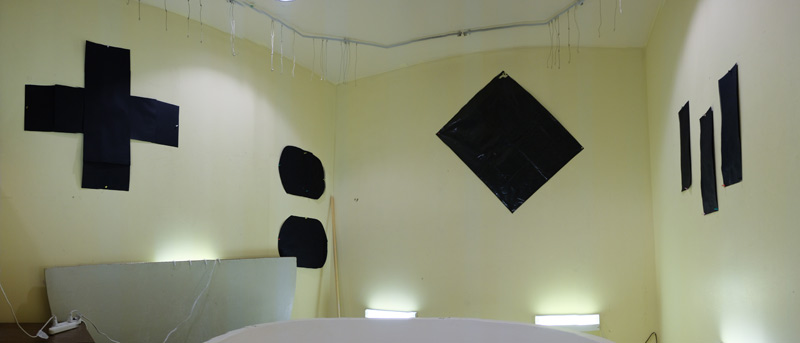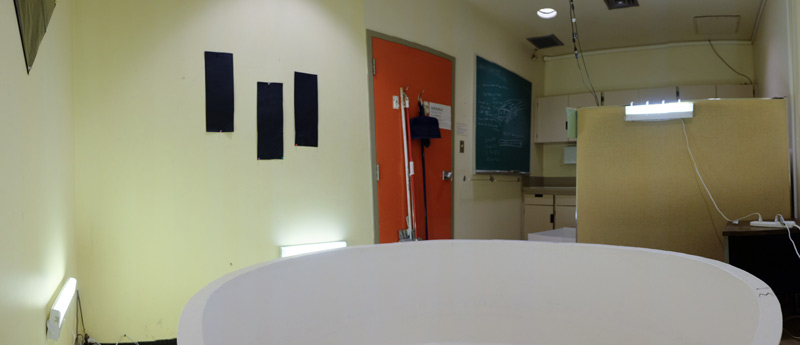Introduction:
One of main research interests in the Snyder lab is exploring the role of adult-born hippocampal neurons in learning and memory, and whether the function of these neurons changes in non-stressful vs. stressful learning situations. To explore this issue we are using the Morris water maze (MWM), arguably the most commonly used test of visuo-spatial learning and memory in rodents (see Figure 1, pictures of water maze). Previous research has shown, that rats generally perform better when tested with stressful cold water, compared to less stressful warm water (Sandi et al., 1997). Furthermore, training on the MWM produces an increase in the stress hormone corticosterone, and this increase is larger in cold water than in warm water. The underlying hypothesis is that the increase in corticosterone due to testing in cold-water is at least partially responsible for the improvements in learning.
Figure 1: Our water maze. The top image shows a view of the north side of the maze, the bottom is a view of the south side.
We are now interested in replicating this temperature effect in our lab, and to determine if the effect is more pronounced in animals that have reduced neurogenesis. We are currently using a transgenic rat that expresses thymidine kinase under the human GFAP promoter, which allows us to prevent adult neurogenesis with the administration of the anti-viral drug Valgancyclovir (Snyder et al., 2011). We expect that water temperature will have a more pronounced effect on the GFAP-TK rats, because reduced neurogenesis in a similar transgenic mouse model results in dysfunction of the hypothalamic-pituitary-adrenal axis (Snyder et al., 2011).
I am also generally interested in this research from a procedural standpoint, given my background examining behavioural test design and procedure in mice. We know there is considerable variability in test parameters across studies using the MWM in rodents, including water temperature (see Wahlsten et al. for a good review in mice). Also, a recent meta-analysis of experiments that ablate adult neurogenesis in rodents did not show a clear effect on memory performance in the MWM, because of considerable variability in results across experiments (Groves et al., 2013). We do not yet know how experimental parameters, like water temperature, influence the size of learning and memory impairments following manipulations that reduce adult neurogenesis.
Over the next few months, we will periodically post the results for some of our initial work looking at the effect of water temperature on performance in the MWM. For the first post, we’ll discuss some of the procedural details that should be considered before using different water temperatures on the MWM.
Things to consider:
Water temperature manipulations are not often done in experiments using the MWM. Also, water temperature experiments do not always produce clear temperature effects on performance (Anderson et al., 2013; Kogan and Richter-Levin 2010), so choosing the optimal experiment design isn’t easy. I’ve described some of the factors we have considered when designing water temperature experiments in our lab.
1) Should male or female rats be used?
Ideally both sexes of animals should be used in any experiment examining the effects of neurogenesis on the MWM, but often experiments are limited to one sex due to practical reasons such as animal availability. The majority of studies examining water temperature effects have used male rather than female rats, probably because corticosteroid levels are known to also change depending on the stage of the estrous cycle. In females, there is evidence that estrous cycle interacts with water temperature, in that rats in proestrous perform better in warm water than cold water, and rats in estrous perform better in cold water than warm water (Rubinow et al., 2004). This may make detection of temperature effects difficult in female rats due to increased variability in performance, but also provides an interesting story concerning interactions between estrous cycle phase and water temperature on performance.
2) Should massed or spaced training be used?
Experiments using water temperature manipulations either give all training trials over one day (massed training), or have split the training over multiple days (spaced training). One main advantage of massed training is that drugs which block corticosteroid synthesis (such as the Metyrapone) could be administered prior to training and their effect over the entire training protocol can be observed (Akirav et al., 2004). However, in spaced training administration of the drugs would occur over several days, which may increase the likelihood of unwanted drug-induced side effects. In general, spaced training is thought to produce better memory than massed training, and we have found that spaced training generally produces better memory in a 24hr probe trial than massed training. We suggest that spaced training may be better suited for the assessment of water temperature effects on memory.
3) Good and poor learners in warm water?
Some studies examining water temperature effects on the MWM have found subpopulations of rats that perform either good or poorly at warm water temperatures (these sub-populations are not found at cold temperatures; Akirav et al., 2004, Arikav et al., 2001). Therefore a large number of animals (N>20) may be needed to permit a break-down of the sample into good and poor learners, yet still ensure enough animals remain for sufficient statistical power to detect water temperature effects. Interestingly, these good and poor learners do not differ in the amount of corticosteroids produced following training (Akirav et al., 2001) so it isn’t clear what is driving this difference in learning performance in warm water.
4) What water temperatures will be used?
Our water maze is located in a room with a sink and we fill the pool using hoses connected to the tap. The water from the tap ranges from 13 to 55 °C, so we are limited to using water within this temperature range. Generally heating the water from the tap is quick but cooling the water is slower, taking as long as 20-30 min to reach 16 °C and 1.5 hours to reach 13 °C. So, we decided to use 16 °C (cold) and 25 °C (warm) for practicality, and also because these temperatures fit well with previous studies (range from 16 to 33 °C). Although it is possible to use wet ice to cool water already in the pool, we found it to be inefficient and you need lots of it. Also we don’t recommend the use of dry ice (don’t ask….).
5) Is there enough time to change the temperature?
When planning the experiment you need to account for the time required to change the water temperature, which will differ depending on the size of the pool. We have a 180cm diameter pool, which is filled to a depth of about 32-33 cm. For each temperature change, we use a sump-pump (can be purchased at local hardware store) to pump water out of the pool and then refill the pool with either cold or hot water. We have found that increasing the water temperature from cold to warm (16 -> 25 °C) takes about 30 min, and requires roughly 10cm of the pool water to be removed before refilling with hot water (50-55 °C). Changing the temperature from warm to cold (25 -> 16 °C) takes longer (1-1.5 hours) and requires 25 cm of the water to be removed before refilling with cold water (~14-15 °C). The added time required to change the water usually limits us to 2 changes in water temperature each training day. Also, the water will warm or cool to room temperature over time, so prolonged testing due to many animals and/or trials may require the water to be re-heated or cooled periodically.
6) Will animals become too cold?
Testing rats in colder water temperatures (<20 degrees), may cause them to become hypothermic. This will produce added stress and impair swimming ability, thus producing impaired performance rather than the improvement in performance commonly found with cold water. Therefore, the inter-trial interval should be sufficiently long to prevent decreases in body temperature. We currently use 4 trials per day, with at least a 1 min inter-trial interval and animals sit under heating lamps between trials. With this procedure swim-speed is generally stable across trials and rats don’t show visible signs of hypothermia.
References:
Akirav, I, Sandi, C, and Richter-Levin, G. (2001) Differential activation of hippocampus and amygdala following learning under stress. European Journal of Neuroscience, 14, 719-725.
Akirav, I., Kozenicky, M., Tal., D., Sandi, C., Venero, C. and Richter-Levin, G. (2004). A facilitative role for corticosterone in the acquisition of a spatial task under moderate stress. Learning and Memory, 11, 188-195.
Anderson, E.M., Moenk, M.D., Barbarno, L., Clarke, D.A., Matuszewich, L. (2013). Effects of pretraining and water temperature on female rats’ performance in the Morris water maze. Physiology and Behavior, 122, 216-221.
Kogan, I., & Richter Levin, G. (2010). Emotional memory formation under lower versus higher stress conditions. Frontiers in Behavioral Neuroscience, 4, 183.
Rubinow, M.J., Arseneau, L.M.,; Beverly, J.L.; Juraska, J.M. (2004) Effect of the Estrous Cycle on Water Maze Acquisition Depends on the Temperature of the Water. Behavioral Neuroscience, 118, 863-868.
Sandi, C., Loscertales, M. and Guaza, C. (1997). Experience‐dependent Facilitating Effect of Corticosterone on Spatial Memory Formation in the Water Maze. European Journal of Neuroscience, 9, 637–642.
Snyder, J., Grigereit, L., Brewer, M., Pickel, J., and Cameron, H. (2011) A transgenic rat model for reducing adult neurogenesis. Available from Nature Precedings.
Snyder, J. S., Soumier, A., Brewer, M., Pickel, J. and Cameron, H. A. (2011). Adult hippocampal neurogenesis buffers stress responses and depressive behaviour. Nature, 476, 458–461.
Wahlsten, D. (2011). Task refinement and standardization. In Mouse Behavioral Testing: How to Use Mice in Behavioral Neuroscience, Chapter 13, pg 215-234. Academic Press.

